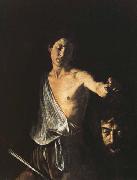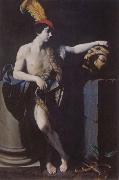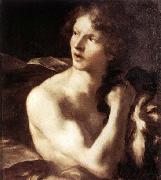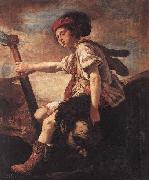
Oil On
Canvas, Real Flavor of Old Masters
|
Caravaggio
|
|||
|
|
|||
| Italian Baroque Era Painter, ca.1571-1610 Italian painter. After an early career as a painter of portraits, still-life and genre scenes he became the most persuasive religious painter of his time. His bold, naturalistic style, which emphasized the common humanity of the apostles and martyrs, flattered the aspirations of the Counter-Reformation Church, while his vivid chiaroscuro enhanced both three-dimensionality and drama, as well as evoking the mystery of the faith. He followed a militantly realist agenda, rejecting both Mannerism and the classicizing naturalism of his main rival, Annibale Carracci. In the first 30 years of the 17th century his naturalistic ambitions and revolutionary artistic procedures attracted a large following from all over Europe. | |||
|
|
|||
|
|
David with the Head of Goliath new2/Caravaggio-836973.jpg Painting ID:: 26765 Visit European Gallery |
mk52 c.1610 Oil on canvas 125x100cm Galleria Borgese,Rome | |
Height Width |
INS/CM |
||
|
X |
|
||
|
|
|||
|
Guido Reni
|
|||
|
|
|||
| 1575-1642 Italian Guido Reni Galleries Born in Bologna into a family of musicians, Guido Reni was the son of Daniele Reni and Ginevra de?? Pozzi. As a child of nine, he was apprenticed under the Bolognese studio of Denis Calvaert. Soon after, he was joined in that studio by Albani and Domenichino. He may also have trained with a painter by the name of Ferrantini. When Reni was about twenty years old, the three Calvaert pupils migrated to the rising rival studio, named Accademia degli Incamminati (Academy of the "newly embarked", or progressives), led by Lodovico Carracci. They went on to form the nucleus of a prolific and successful school of Bolognese painters who followed Annibale Carracci to Rome. Like many other Bolognese painters, Reni's painting was thematic and eclectic in style. By late 1601, Reni and Albani had moved to Rome to work with the teams led by Annibale Carracci in fresco decoration of the Farnese Palace. During 1601-1604, his main patron was cardinal Sfondrato. By 1604-1605, he received an independent commission for an altarpiece of the Crucifixion of St. Peter. After a few year sojourn in Bologna, he returned to Rome to become one of the premier painters during the papacy of Paul V (Borghese). From 1607-1614, he was one of the painters patronized by Borghese. Abduction of Deianira, 1620-1621.Reni's frescoed ceiling of the large central hall of garden palace, Casino dell'Aurora located in the grounds of the Palazzo Pallavicini-Rospigliosi, is considered his masterpiece. The casino was originally a pavilion commissioned by Cardinal Scipione Borghese; the rear portion overlooks the Piazza Montecavallo and Palazzo del Quirinale. The massive fresco is framed in quadri riportati and depicts Apollo in his Chariot preceded by Dawn (Aurora) bringing light to the world. The work is restrained in classicism, copying poses from Roman Sarcophagi, and showing far more simplicity and restraint than Carracci's riotous Triumph of Bacchus and Ariadne[5] in the Farnese. Reni in this painting is allies himself more with the sterner Cavaliere d'Arpino,Lanfranco, and Albani "School" of mytho-historic painting, and less with the more crowded frescoes characteristic of Pietro da Cortona. There is little concession to perspective, and the vibrantly colored style is antithetical to the tenebrism of Caravaggio's followers. Payments showed that he was paid in 247 scudi and 54 baiocchi upon completion on 24 September 1616. He also frescoed in Paoline Chapel of Santa Maria Maggiore in Rome as well as the Aldobrandini wings of the Vatican. According to rumor, the pontifical chapel of Montecavallo (Chapel of the Annuciation) was assigned to Reni to paint. However, because he felt underpaid by the ministers, the artist left for Bologna, leaving the role of the preeminent artist in Rome to Domenichino. | |||
|
|
|||
|
|
David with the Head of Goliath new16/Guido Reni-945329.jpg Painting ID:: 40409 Visit European Gallery |
mk156 c.1605 Oil on canvas 237x137cm | |
Height Width |
INS/CM |
||
|
X |
|
||
|
|
|||
|
Gian Lorenzo Bernini
|
|||
|
|
|||
| Italian sculptor , b. 1598, Napoli, d. 1680, Roma ,Italian architect and artist credited with creating the Baroque style of sculpture. He began his career working for his father, a sculptor. Among his early sculptures are Apollo and Daphne (1622 -C 24) and an active David (1623 -C 24). Under the patronage of Urban VIII, the first of eight popes he was to serve, he created the baldachin over the tomb of St. Peter in Rome. Bernini's architectural duties increased after 1629, when he was appointed architect of St. Peter's Basilica and the Palazzo Barberini. His works often represent a fusion of architecture and sculpture, as in the Cornaro Chapel, in Santa Maria della Vittoria, Rome, with its celebrated theatrical sculpture, The Ecstasy of St. Teresa (1645 C 52). His greatest architectural achievement is the colonnade enclosing the piazza before St. Peter's. | |||
|
|
|||
|
|
David with the Head of Goliath new18/Gian Lorenzo Bernini-554742.jpg Painting ID:: 51190 Visit European Gallery |
1625 Oil on canvas, 75 x 65,5 cm | |
Height Width |
INS/CM |
||
|
X |
|
||
|
|
|||
|
FETI, Domenico
|
|||
|
|
|||
| Italian Baroque Era Painter, ca.1589-1624 | |||
|
|
|||
|
|
David with the Head of Goliath new21/FETI, Domenico-737227.jpg Painting ID:: 63052 Visit European Gallery |
1620 Oil on canvas, 153 x 125,1 cm Royal Collection, Windsor Feti was a peripatetic artist. Having been trained in Rome by the Florentine painter, Lodovico Cigoli, he worked at the court of Mantua from around 1613 and towards the end of his life spent some time in Venice. His principal patron was Duke Ferdinando Gonzaga at Mantua and it was with the purchase of the Gonzaga collection in 1625-27 that Charles I acquired a number of works by Feti. The artist was influenced by Venetian painters, as well as by Elsheimer and Rubens. His portraits and a series of small-scale pictures illustrating parables, probably commissioned by Ferdinando Gonzaga, are perhaps his best works. The artists technique is distinctive, with rapid brushstrokes of pure colour applied as highlights over broader areas of paint on canvases primed with dark tones. Similarly, the poses of his figures and the choice of viewpoints are often unusual. David with the Head of Goliath almost certainly formed part of the Gonzaga collection. A version of some quality is in Dresden (Staatliche Kunstsammlungen) and others are recorded. A date around 1620 has been suggested, that is, before the artist moved to Venice in 1622. The pose is somewhat reminiscent of the Ignudi by Michelangelo on the ceiling of the Sistine Chapel in Rome, and it is possible that the painting was meant to be hung as an overdoor. The present work depicts the story of David and Goliath as recounted in the first Book of Samuel, 17:48-51. The shepherd boy, David, defeats Goliath, the champion of the Philistines, in single combat using a sling with a stone. Afterwards David cuts off Goliath's head using the giants own sword. The body of Goliath is visible on the left in the middle distance. Feti cleverly contrasts the large scale of the decapitated head and sword with David's smaller body. Artist: FETI, Domenico Painting Title: David with the Head of Goliath , 1601-1650 Painting Style: Italian , , religious | |
Height Width |
INS/CM |
||
|
X |
|
||
|
|
|||










